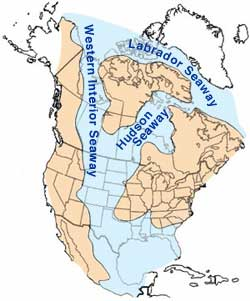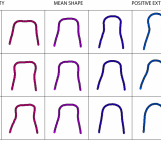What comes to mind when you think of dinosaur interaction? Large carnivores chomping on unsuspecting little ornithopods? Ceratopsians jousting for their next mate? Large hadrosaurs tenderly mothering their cute newborns? There are many possible images of community-level dinosaur interactions, and there is a host of evidence out there that take dinosaurs beyond the bones and breathe new life into how they lived.
Now, cast your mind back in time, about 75 million years ago to North America. It was an entirely alien world back then – a vast sea cut the continent in half, with a mountainous region on the west host to such spectacular arrays of animals that if you were to be there, you’d probably get lock jaw. Or eaten. This was Laramidia. It’s eastern sibling was known as Appalachia, and we know a lot less about its constituent faunas, but the few fossils suggest that it was pretty different to Laramidia.
The dinosaurs in Laramidia were, simply put, awesome. From towering sauropods, to herds of hadrosaurs, and the bizarre therizinosaurs to the nimble hypsilophodontids. Carnivores included the notorious Tyrannosaurus rex, dromaeosaurs, and the intelligent troodontids. This eclectic mix during the sub-continents existence has often puzzled scientists trying to recreate the ecosystems – largely, how did so many herbivorous dinosaurs co-exist together?
Consider a modern ecosystem, like the Savannah. You have the giraffes chomping away up high, and longer-necked ungulates forming vast herds that nosh away at bushes lower to the ground. This is known as ‘niche partitioning’ – a niche is essentially x-dimensional ‘ecospace’, and means quite little in a comparative sense, but is useful as a concept for considering how an animal or groups of animals interact and fit into their surrounding ecosystems.
It has been suggested previously that dinosaurs too used niche partitioning in a way of managing resources, through varying their morphology in aspects like jaw mechanics and tooth shape, snout shape, and feeding height, known as stratification. For this final aspect, the theoretical basis is that sauropods feed up high like giraffes, smaller dinosaurs like ankylosaurs eat lower to the ground, and hadrosaurs occupy the middle ground.

Heights of some hadrosaur species, with oddly waving human for scale (but no scale for the human..?)
A new study has analysed this final factor, using a true dinosaur graveyard. Alberta, Canada, plays host to the most diverse dinosaur assemblage currently known, with at least 15 omnivorous and herbivorous species co-existing at any one time and place, and with at least 8 megaherbivores making that electric mix up. Feeding stratification of this sort has been suggested in sauropods before, and other groups of dinosaurs, but hasn’t ever really been sufficiently tested, until now.
Using estimates of maximum feeding heights, based on a combination of actual height, neck flexibility, and posture variation, the team found a height dichotomy between smaller dinosaurs like Stegoceras at around 1 metre, and larger hadrosaurs like Lambeosaurus at 2-5 metres, depending on whether they were constructed as bipedal or quadrupedal. This posture shift may have been developed, in part, so that different hadrosaurs could exploit different layers of the vegetation, and could be responsible for why they came to dominate Late Cretaceous ecosystems.
What this means then is that ankylosaurs, small ornithopods, ceratopsians and all the other little veggiesaurs competed among a similar height in the vegetation layer. This might also explain some of the morphological differences that we see in the functional aspects of their feeding morphology; for example, ceratopsians had pointed ‘beaks’ and teeth for slicing, whereas hadrosaurs had ‘dental batteries’, rows of teeth acting as immense grinding surfaces. This might explain how they got particularly bigger than the other dinos too, perhaps. Within the smaller dinosaurs, it might be some sort of selectivity factor that meant they could all occupy the same ‘niche’, or perhaps there was just enough food to go around!
It would be cool to see how other factors of feeding strategy help to solve this riddle. Did the herbivores eat different types of plant from the same feeding height, or were some more selective than others, as has maybe been found in forthcoming publications.. *hint hint* Alternative suggestions could be that the local tyrannosaurs, dromaeosaurs and flesh-munching beasties were efficient and numerous enough to constantly suppress herbivore populations, such that there was no need for specialisation and niche partitioning! From the other end, perhaps primary productivity was high enough that there were enough plants to go around, so that the Late Cretaceous of North America was pretty much just the salad bar at Pizza Hut..
Reference: Mallon et al. (2013) Feeding height stratification among the herbivorous dinosaurs from the Dinosaur Park Formation (Upper Campanian) of Alberta, Canada, BMC Ecology, 13, link (free to read!)
![]()
Jordan C Mallon1, David C Evans, Michael J Ryan, Jason S Anderson (2013). Feeding height stratification among the herbivorous dinosaurs from the Dinosaur Park Formation (upper Campanian) of Alberta, Canada
BMC Ecology DOI: 10.1186/1472-6785-13-14





Jaime A. Headden
You know what we need? Dino poo, and lots of it.
Jon Tennant
More of this? http://i.qkme.me/3ojw3t.jpg
Dennis
Loved this article a lot 🙂
‘(but no scale for the human..?)’ – there are scales is all over the picture, because the squares are 1 meter by 1 meter 😉
Jon Tennant
And that’s how I failed my PhD.. 😉
Rob
This is an interesting post. However, you wrote “This was Laramidia. It’s western sibling was known as Appalachia”. It should read “eastern sibling”.
Jon Tennant
Aha, you spotted the one deliberate error in the post – thanks! 😉